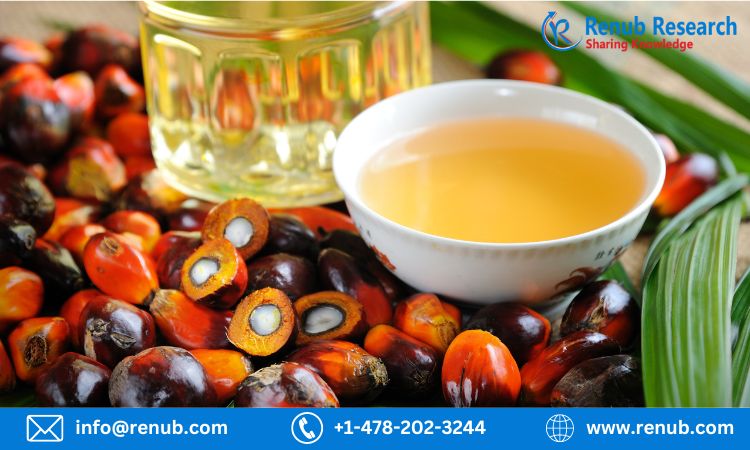The Global palm oil market will grow at a 4.72% CAGR, from 2023 to 2028.One-third of all plant oils produced globally are made from palm oil, one of the most accessible and affordable plant oils. Palm oil comes from the fruit of oil palm trees and is a member of the Elaeis genus producing about one-fifth of the world's oil and fat. The two species that make up the genus Elaeis are the American oil palm (E. oleifera) plus the African oil palm (E. guineensis).
Palm oil is used in a various-industries, including energy, biofuel, cosmetics, food, and beverage. Especially in Southeast Asia's Malaysia and Indonesia, oil palm plantations have increased. Currently, these two countries produce more than 80% of the palm oil used worldwide. Due to the numerous players competing for market share through high production, superior distribution networks, high-quality products, and different competitive strategies, the market is both fiercely competitive and wide-ranging in scope.
Food producers prefer palm oils because they make it easier to preserve flavor and uniformity in processed foods while also stabilizing them. Palm oil can be utilised as both a crude oil and a refined oil. It has a vivid orange color in its natural state since it is extracted from the orange pulp of the oil palm tree's fruit. Global palm oil market will increase to US$87.40 Billion by 2028 due its high oil yields per hectare, widespread use of palm oil in numerous industries, and accessibility. A recent report from Renub Research, "Global Palm Oil Market: Global Industry Trends, Share, Size, Growth, Opportunity, and Forecast 2022-2028," offers a detailed market share information, in-depth industry analysis, and evaluations of various geographic areas, rivals, and the current market expansion.
Request a free sample copy of the report: https://www.renub.com/request-sample-page.php?gturl=palm-oil-market-p.php
The production of this priceless resource has increased significantly as a result of the growing demand for it as a source of fuel and nutrition. Furthermore, the elimination of GMOs, gluten, and milk from edible fats, including palm oil, is catching the attention of consumers all over the world. Along with having a longer shelf life and being less expensive than other vegetable oils, the product is expected to have greater market growth as more people become aware of its health benefits.
From a consumption standpoint, Indonesia rules the global palm oil market.
According to industry association Gapki, Indonesia consumed 1.89 million tons of palm oil in April, 776,000 of which came from biodiesel. In Indonesia, which has the fourth-largest population in the world with more than 270 million people, there is a sizable demand for flexible and affordable palm oil as a cooking oil. Growing demand for processed foods containing palm oil is fueled by the middle class, and it is predicted that government initiatives to support the use of palm oil in biodiesel and other industrial uses will further increase local demand. Low production costs, a favorable climate, fertile soil, and a sizable labour pool are all advantages for Indonesia's palm oil industry.
Consumption – Global Palm Oil Market has been covered from sixteen viewpoints.
- Indonesia
- India
- China
- the European Union
- Malaysia
- Pakistan
- Thailand
- the United States
- Nigeria
- Bangladesh
- Colombia
- the Philippines
- Egypt
- Vietnam
- Brazil
- Others
Crude Palm Oil (CPO) is the most popular form in the global palm oil market.
Due to the efficient use of land, CPO (Crude Palm Oil) offers yields up to 10 times higher than those of other vegetable oils. In the biodiesel, food, and cosmetics industries, it is highly favored by producers due to its adaptability. It is perfect for processed foods because of its inherent stability, ensuring a long shelf life and prevents rancidity over time. Consumers in developing nations are drawn to CPO because it is less expensive than more expensive alternatives like olive and canola oils. CPO is widely available worldwide, with Indonesia and Malaysia serving as producers.
Form- Global palm oil market has been examined from four angles.
- Palm Kernel Oil
- Crude Palm Oil
- RBD Palm Oil
- Others
The primary end-user in the global palm oil market is the food and beverage sector.
Palm oil is excellent for frying because of its high smoke point and resistance to rancidity. It can also be used in a variety of processed foods, baked goods, and snacks. Because it is more affordable than more expensive substitutes like olive oil and canola oil, palm oil is a preferred option for food manufacturers. Its suitability for food products is also boosted by the functional qualities of palm oil, such as its capacity to thicken and emulsify, which help to maintain the suspension of ingredients and provide a smooth texture.
End-Users – Five approaches are taken to study the global palm oil market.
- Biofuel and Energy
- Pharmaceuticals
- Food and Beverages
- Personal Care and Cosmetics
- Other sectors
Indonesia is likely to remain the world's top palm oil producer, in the future.
According to a study by the United States Department of Agriculture (USDA), increased yields will cause Indonesia's palm oil production to rise by 3% to 46 million metric tons in the year 2023–24 compared to the year earlier. Indonesia benefits from a warm, humid climate with plenty of rainfall, which makes it the perfect place to grow palm oil trees. Its expansive landmass, the largest in the world at over 17 million hectares, is suitable for palm oil cultivation. The government has long supported the palm oil sector with subsidies, tax breaks, and other producer incentives. Compared to Malaysia and other nations with higher labour costs, Indonesia has lower labour costs, making it a more affordable hub for the palm oil production. Indonesia has produced palm oil for more than 100 years and has strong expertise in the sector.
Production – The global palm oil market has been examined from six perspectives.
- Indonesia
- Malaysia
- Thailand
- Colombia
- Nigeria
- Others
China is the fastest growing in the global palm oil import market.
The world's most populous country, China, which has over 1.4 billion inhabitants, is one of the major importers and consumers of palm oil, which is widely used for cooking and is both versatile and reasonably priced. The preference for processed foods containing palm oil is rising as China's economy and incomes rise. Changing dietary habits that favor snacks and convenience foods also increase demand because palm oil is useful for frying and extending shelf life. Many government initiatives, including producer subsidies, tax breaks, and investment incentives, have contributed to the continued success of the palm oil industry in China.
Import – Global Palm Oil Market has been covered from eleven viewpoints.
- India
- China
- the European Union
- Pakistan
- the United States
- Bangladesh
- Malaysia
- Egypt
- the Philippines
- Kenya
- Other countries
Indonesia is expected to remain the world's leading exporter of palm oil for many years to come.
Indonesia is in a good position to meet the growing global demand for palm oil because of its capacity to expand production and its proximity to significant Asian markets. Indonesia has distinct advantages, including lower labour costs and a more favorable climate. The government's supportive measures, such as producer subsidies, tax breaks, and investment incentives, have helped Indonesia's palm oil sector to continue expanding.
Export – Global Palm Oil Market has been covered from six viewpoints.
- Indonesia
- Malaysia
- Guatemala
- Colombia
- Papua New Guinea
- Other nations
Competitive Landscape.
Archer-Daniels, Wilmar, AAK (Aarhuskarlshamn), Bunge, Cargill, POSCO, Sime Darby, and Unilever are some of the rival companies in the global palm oil market.
Company Insights has been studied from two perspectives.
• Overview
• Recent Development and Initiatives
Company Analysis.
- Archer-Daniels
- Wilmar
- AAK (Aarhuskarlshamn)
- Bunge
- Cargill
- POSCO
- Sime Darby
- Unilever
Browse Related Report:
Global Fish Oil Market: https://www.renub.com/fish-oil-market-p.php
Global Vegetable Oil Market: https://www.renub.com/vegetable-oil-market-p.php
About the Company:
Renub Research is a Market Research and Information Analysis company with more than 15 years of experience in Research, Survey, and Consulting. Our research helps companies to take business decisions: on strategy, organization, operations, technology, mergers & acquisitions, etc. Till now we have published more than 7000 syndicated reports and worked on more than 500 custom research projects. Currently, we are supplying data to EMIS, Bloomberg, Thomson Reuters, etc. We support many blue-chip companies by providing them with findings and perspectives across a wide range of markets.
Contact Us:
Renub Research
Phone No: +1-478-202-3244 | +91-120-421-9822 (IND)
Email: info@renub.com
LinkedIn: https://in.linkedin.com/company/renub-research
Web: www.renub.com
Media Contact
Company Name: Renub Research
Contact Person: Rajat Gupta
Email: Send Email
Phone: +1-478-202-3244
Address:Roswell, GA 30076 http://www.renub.com/
City: Roswell
State: GA
Country: United States
Website: https://www.renub.com






